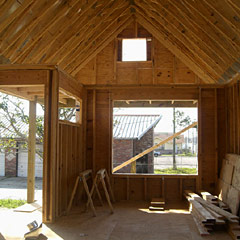When Hurricane Katrina made landfall in Mississippi on August 29, 2005, the storm’s 125-mile-an-hour winds and 25-foot wall of seawater ground homes, boats, and businesses into matchsticks across the state’s three coastal counties: Jackson, Hancock, and Harrison. The cities of Waveland and Bay St. Louis, roughly 20 miles east of the Mississippi-Louisiana state line, were practically flattened; whole neighborhoods were destroyed in larger cities like Biloxi and Gulfport. In the end, Katrina damaged over 94,000 homes across the three counties, according to the U.S. Department of Housing and Urban Development, with those in moderate- and low-income communities the hardest hit. Nearly three years later, the counties and their communities are still trying to recover.
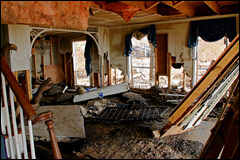
A Biloxi home after Katrina hit.
Photo: Architecture for Humanity
Although rebuilding has been slow, an innovative program in Biloxi is assisting low-income families in getting out of their FEMA trailers and back into affordable homes. In the process, it’s creating blueprints for how people living in the path of the Next Big Bad from the Gulf of Mexico can do so more environmentally soundly, safely, and affordably.
But should communities be re-established in a place that’s nearly certain to be walloped again?
Considering the Options
The Army Corps of Engineers took on that question after Katrina, when Congress directed the agency’s Mobile District to come up with recommendations for reducing damage from future storms on the Gulf Coast. “What we’d like to end up with is a more resilient coast, and more resilient communities along the coast,” says Susan Rees, the program manager for the Army Corps’ Mississippi Coastal Improvements Program.
The MsCIP has generated proposals for Mississippi that range from bolstering seawalls, to building a levee here and there, to restoring wetlands, coastal forests, and barrier islands in the Gulf of Mexico that would act as natural barriers and floodwater storage. The Army Corps has also investigated the feasibility of buying out tens of thousands of homes and businesses in Mississippi’s three coastal counties, at an estimated cost of perhaps $4 billion, and letting the land return to a more natural environmental condition.
In September 2007, shortly after the public learned about the buyout proposal, the corps found itself hosting a town hall meeting in Hancock County, with hundreds of coast residents packing the Bay Waveland Middle School Cafeteria to express reactions ranging from interest to outrage. Some thought their homes and communities were being deemed expendable and resented it, says Sherry-Lea Bloodworth, executive director of the Hancock Housing Resource Center. “If you lived in Los Angeles and there was an earthquake, and they said don’t rebuild because there will be another earthquake, how would you feel?”
But at least one small Jackson County community — Pecan, in far southeastern Mississippi — has told the Army Corps that if Congress ultimately approves the buyout plan and appropriates the funds, it would like to leave its particular piece of wet pine savannah behind in favor of a much drier location, thank you very much. “This is an area that has flooded historically, and it was really severely damaged from Katrina,” says Rees, who stresses that such buyouts would always be voluntary.
Rees also says that the Army Corps is trying to account for future variables in its long-term MsCIP planning, ranging from how sea-level rise could affect the frequency and force of Gulf Coast hurricanes, to whether and how much storm protections decrease the population’s readiness to evacuate. “It’s a different twist than anything we’ve done in the past,” says Rees. “We just understand that we have to be very, very careful in how we tell people things. We can’t tell them that they are protected, because they’re not.”
Design on a Dime
“We discuss every day whether or not an area destined to be flooded should be rebuilt,” says Michael Grote, who directs the Biloxi Model Home Program. In partnership with the East Biloxi Coordination Relief and Redevelopment Agency and the Gulf Coast Community Design Studio of Mississippi State University, the program is spearheading the creation of seven demonstration homes in the neighborhood that feature storm-savvy designs at an affordable cost. “Our code of ethics demands that we ask if we’re putting someone in harm’s way, are we sufficiently mitigating the risk?”
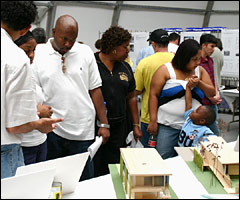
Residents and architects meet at a Model Home fair.
Photo: Architecture for Humanity
Many residents of East Biloxi had no intention of leaving despite the massive damage and likely risks, says Grote. In some cases their homes were their only asset, he says, leaving little choice about repairing or rebuilding. Or they simply didn’t want to abandon the neighborhood their families had lived in for generations — certainly not because of something as unremarkable as a hurricane. “Most of them have been through Camille, and thought that was going to be the worst” until Hurricane Katrina, Grote says, referring to the catastrophic 1969 hurricane that also flattened most of the Mississippi coast. “It’s a part of their life.”
Given that it’s “impossible to transplant a neighborhood elsewhere,” as Grote says, the question becomes, “How do we rebuild in a way that’s smart?”
One smart thing is to minimize the negative environmental impacts of construction and repair. There, too, restoring East Biloxi was a good choice. “More than any gizmo, gadget, or foam,” says Grote, “the most sustainable thing we can do is build back where the infrastructure is still there: electricity, water, sewer, streets, roads, schools.”
The model homes, in addition to hewing to a modest budget — the original target was around $120,000; costs on the ground have proven closer to $140,000 — have to meet complex structural prerequisites for rebuilding in the flood zone. “The program was designed to surpass even FEMA’s engineering requirements,” says Bloodworth, who was the program’s first director, “and use much more innovative construction and design.”
Each house’s design sets it several feet above the ground on pilings, a great solution to endemic flooding that, surprisingly, isn’t common to residential building in the region, according to Grote — who adds that the project initially had trouble finding contractors who would drive piles on a residential scale, especially to the program’s desired 10-foot depth that would better stabilize a house on water-saturated soil.
Designing a house that was affordable and that “rebuilt a family” were just parts of the challenge, says Chung Nguyen of MC2 Architects, one of several firms invited to participate in the Model Home Program. The mandate was also “how to bring the community back, and how the pattern of the city can be rebuilt,” he says, “not just rebuilding so that in 10 or 15 years we have the same problem.”
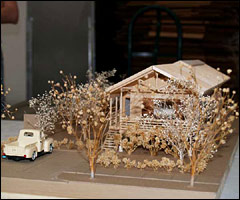
The MC2Architects design.
Photo: Architecture for Humanity
The bungalow solution his firm devised — which was chosen by two of the seven families participating in the pilot program — floats nine feet off the ground on pilings, and is engineered to withstand hurricane winds up to about 140 miles per hour. It has a modular design that makes it easy to adapt to different properties: for the Nguyens (no relation to their architect), a family of six, the new home will accommodate a beloved oak tree that survived Katrina; the new home of husband and wife Hiep Tran and Lang Tho Do will feature a large porch that faces the neighborhood streets, providing shade while allowing the older couple to sit comfortably and interact with their neighbors.
“What we provide them is a very minimal house in the beginning,” Nguyen says. “Hopefully as the situation there recovers, and with steady jobs, people can make money, and begin to add on to the house.”
MC2 Architects based its design on regional architectural traditions that can ultimately cut down on energy use. “We take the shotgun house that’s prevalent throughout the Gulf Coast region, because it’s proven to work with the climate,” says Nguyen. “The whole idea is that you can open the door and let the air move through the house during the summer months.” The slanted roof sheds rain, with deep overhangs shielding the windows; lockable shutters will allow the families to sleep safely with open windows, and also to protect the windows from flying debris in a future storm.
Nguyen says that both the Tran and Nguyen residences, still under construction, are averaging around $58 per square foot, compared to the $110 per square foot that he hears is closer to the norm in Biloxi. The low cost has enabled him to plan a more spacious residence for each family than they might otherwise have been able to afford — including four bedrooms for each of the Nguyen’s teenage children and a master bedroom for the parents. Cong Nguyen, a shrimp boat mechanic, says he’s very happy about the new home; his expression is limited by natural shyness as well as imperfect English. His 13-year-old daughter, Bach Yen, says she’s looking forward to having her own bedroom when they finally move into the house.
Earthly Possessions
Although green materials can drive up the cost of a residence, the East Biloxi model homes incorporate some low-impact materials while staying on budget, says Grote, including no-VOC paints, bamboo flooring where possible, and fiberboard siding instead of vinyl. He’s especially pleased that they’ve been able to use a spray foam insulation based on soybean oil instead of petroleum products, saying that it’s an extremely energy-efficient material more typical to higher-end green construction. “It’s more expensive up front, but saves money down the road” by reducing utility bills.
The landscaping around the model homes will include new oaks, magnolia, plum, and other native trees in spots where they’ll create good shade — albeit in about 20 years. These young trees don’t quite replace the many venerable oak trees, some over two centuries old, that Biloxi lost to Hurricane Katrina. But it’s a start.
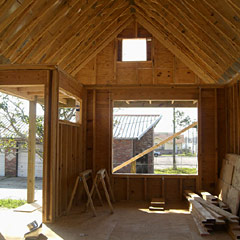
The rebuilding begins.
Photo: Emily Pilloton
Detailed information for each Model Home Program design has been posted online at Architecture for Humanity’s free Open Architecture Network; the group hopes to see them more widely implemented throughout coastal Mississippi, and adapted anywhere else that’s prone to similar weather. The program has also gotten funding to help with the repair of hundreds of East Biloxi homes that were not damaged beyond recovery, and in some cases has suggested to homeowners that they sell their property — spots where, for instance, “we would have to elevate the home 18 feet off the ground” to be safe, says Grote — and move to a lower-risk area. But ultimately, it’s up to the people who call the place home.
West of Biloxi, Sherry-Lea Bloodworth is bringing the lessons of the Model Home Program to rebuilding affordable housing in Hancock County’s cities and towns. “Seventy percent of all housing stock in Hancock County was destroyed outright or not recoverable, affecting 44,000 residents,” she says, and most of the county’s affordable housing was severely damaged. In Waveland, 95 percent of all buildings were destroyed or severely damaged, she says. “In Bay St. Louis, not much better.”
And yet, as in Biloxi, there are lowland communities in these cities where some families have lived for generations, and seem to want to stay despite the risks. “It’s bigger than just ‘move them out of there,’ ” says Bloodworth. “These are lives. Where are they going to go?”

